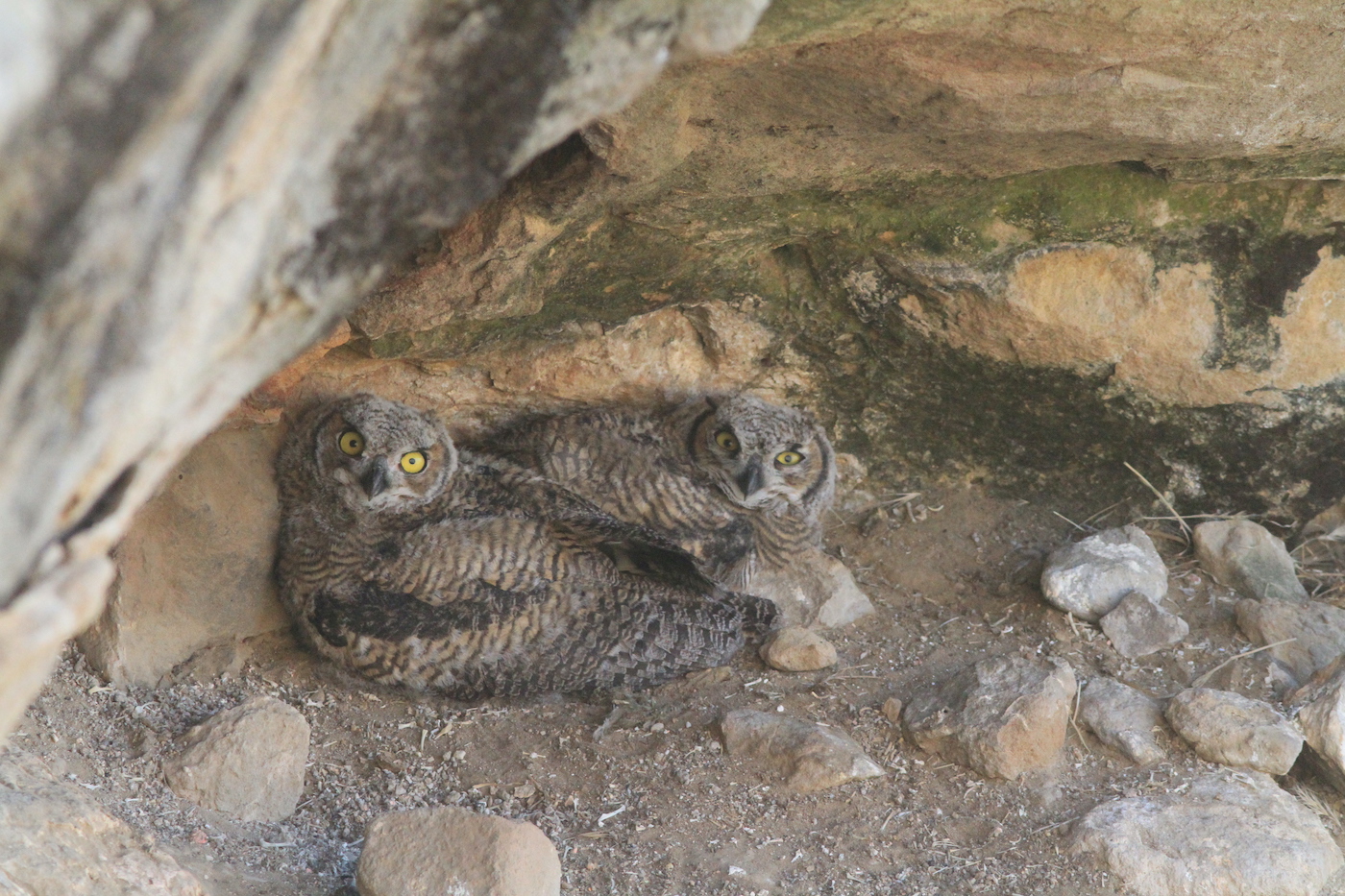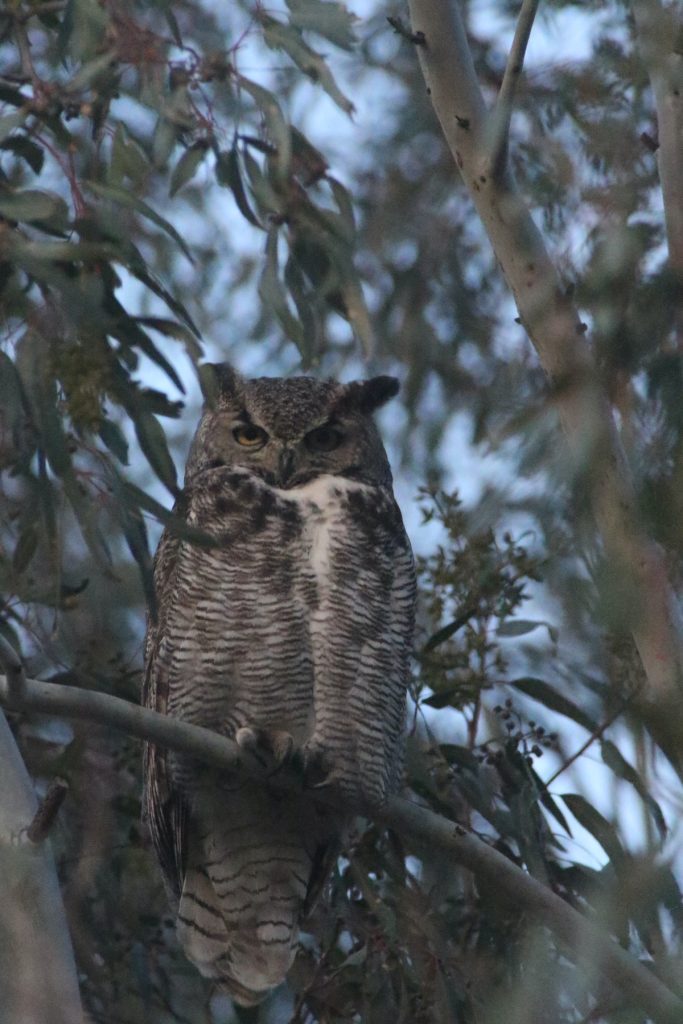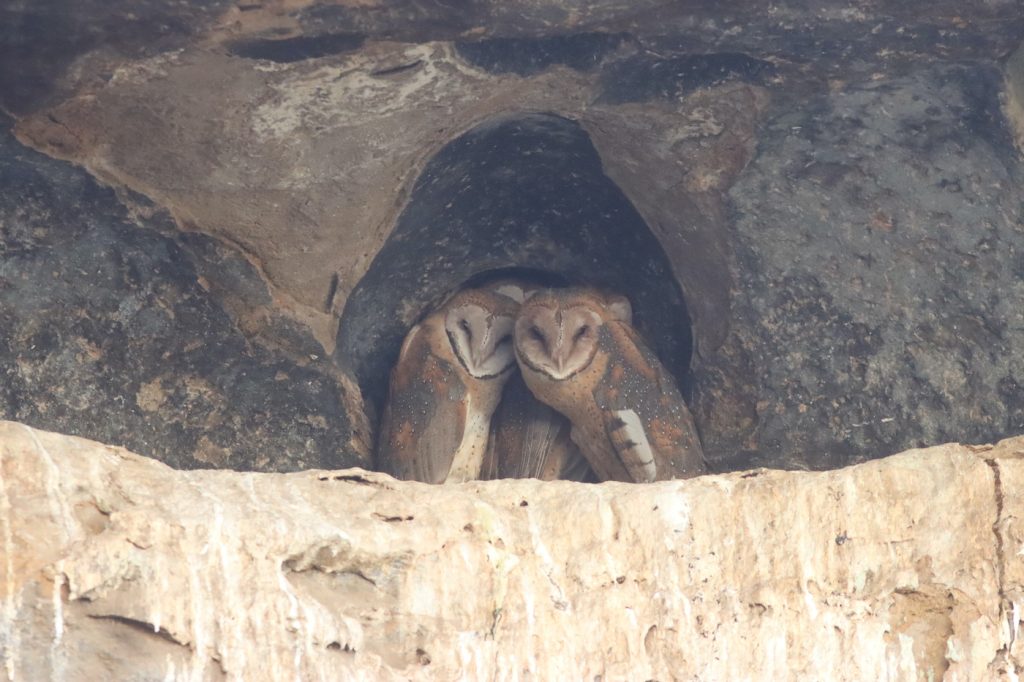Gone Owls

The prominent sandstone rock outcropping was riddled with gritty alcoves, clefts, lofty ledges, and shadowy caves. As I scanned with binoculars for any feathered occupants, I found five barn owls nesting in the upper reaches of this remote, sandstone cathedral.

However, there was something else that caught my attention while attempting to conceal themselves 20 feet off the ground at the edge of a shallow grotto. Peering through my binoculars, I could feel their piercing yellow eyes boring a hole into me. It was a pair of great horned owlets peeking from behind a slab of sandstone. Astonishingly, they were in their nest just several feet away from the barn owls. That seemed odd to me, two territorial owl species nesting so close to one another.
As I slowly approached from below, I came a across a fresh barn owl carcass. I tried wearing my outdoor/wilderness detective hat, but to know for certain what occurred was out of my realm of thinking. I could only imagine with two species of owls nesting so close to one another, there may have been a lethal confrontation. Whether it was on the sandstone or in the air, the barn owl would’ve been no match for a great horned owl.
The lone adult barn owl kept its four owlets in the back of their alcove nest, shielding them from any threats. What was not apparent were the adult great horned owls. Their owlets huddled together by themselves exposed to attacks by marauding ravens and any other raptors in the vicinity. I climbed up the backside of the sandstone rock outcropping, my curiosity knowing no bounds. I slid down a knobby slope into a convenient saddle offering an unfettered view of the great horned owlets. They appeared healthy and well-fed. They were still cloaked in downy feathers. Small bones were scattered around them, evidence their parents were bringing them food.
A week later I returned, my curiosity never waned. The barn owl carcass had been moved around, probably a play toy for coyotes or kit foxes foraging in the night. The barn owlets had fledged and were flying, circling above. One of the great horned owlets stared at me from across the sandstone cathedral. It perched itself in a shallow cave allowing me to approach to within several feet. Those piercing yellow eyes were like lasers, yet the raptor roosted calmly never twitching, nor a feather fluttering in the shadows of the sandstone.
Gradually, I stepped light-footed away from the owls, never knowing what had transpired amongst two owl species closely related, yet willing to defend their own to no end. After I exited the sandstone monolith, the young great horned owlet took flight quickly vanishing behind the sandstone never to be seen again.
Night Moves
Some nights are best with little or no sleep. After laying out my sleeping pad and sleeping bag in the back of my truck, I stretched out beneath the trees and a starry night, shooting stars plentiful over the Carrizo Plain National Monument. While relaxing, I was serenaded by yelping packs of coyotes, but more prevalent throughout the night was the incessant sounds of great horned owls. The KCL Campground is known for its great horned owls nesting annually in the tall grove of eucalyptus trees that shade the campsites.

I spotted both adult great horned owls high in the trees at dusk, those deep, soft hoo-h’HOO-hoo-hoos in rhythm, and a dead giveaway. They sound off as such to defend their territories, the male and female performing a sort of duet, trading off with their hoots, the female’s calls possessing a higher pitch than the male. Many times throughout the night I dozed off only to be woken by the melodic pair. It didn’t help that they were directly above my truck, but at the same time their hoots were soothing and floated across the grasslands surrounding the campground.
Earlier in the evening, I ran into a woman camping with her husband. We were the only ones there. I was returning from behind the car camping sites where I was attempting to photograph busy giant kangaroo rats that emerge just after dark from their maze of burrows to feed. As usual they were very quick and tough to capture as they hop from burrow to burrow. The woman told me a great horned owl had dropped what was left of a giant kangaroo rat carcass onto the shoulder of her husband startling them both as they pitched their tent. Those giant kangaroo rats provide food for so many species that inhabit this unique grassland biome, reliable fodder for keen great horned owls.
Call of the Owl
I didn’t purposely park my truck underneath a tree where the great horned owls roost. The night began with no owls overhead as I snoozed heavily in the bed of my truck, but before midnight it was a symphony of whistles, barks, shrieks, hisses, coos, and wavering cries. There was no warning of their presence above. Great horned owls are equipped with extremely soft feathers that not only insulate them on those cold winter nights on the grasslands, but those soft feathers and short, wide wings allow them to fly stealthily, and effortlessly in thick foliage. With that being said, I never heard them land in the tree above.
After being woken up, their incessant calls eventually had a reverse effect, and I fell back to sleep. As the night wore on, most of their calls resulted into consistent, soft coos, a soothing way to be lulled back into a fitful slumber out on the cool, crisp open grasslands.
Before sunup, I bounced out of the bed of my truck with my binoculars. All was quiet in the KCL Campground. I scanned all the treetops for those great horned owls. Sure enough, in the upper reaches of one tree was the steely gaze of a great horned. Their eyes don’t move in their sockets, but they have the uncanny ability to swivel their heads more than 180 degrees in any one direction. There isn’t much they miss with that unique physical characteristic, but it gets better. They also possess sensitive hearing due to facial disc feathers that direct those sound waves to their ears. And at night their pupils set within large yellow eyes open widely in the dark, their retinas containing many cell rods that enhance their stellar night vision. It’s a wonder their prey items have any chance at all day or night.
From sunrise until sunset, the great horned owls are quiet in the KCL Campground, but make no mistake, they are wary of everything going on around them in the trees and on the grasslands. They may appear to be drowsy while perched high in the treetops, but all their amazing physical components carry them through the day, and especially at night relying on stealth and darkness, their allies across the grasslands.







